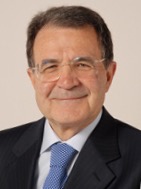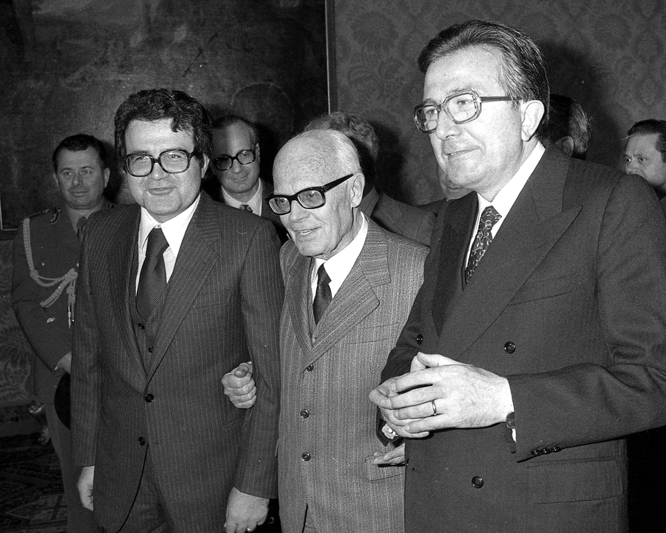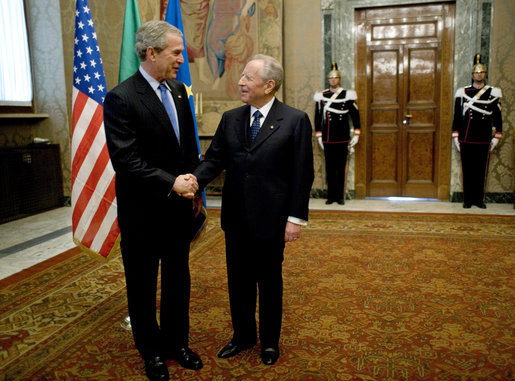|
Prodi II Cabinet
The second Prodi government was the cabinet of the government of Italy from 17 May 2006 to 8 May 2008, a total of 722 days, or 1 year, 11 months and 21 days. The 59th cabinet of the Italian Republic, it was the only cabinet of the XV Legislature. It was composed of 24 ministers, 10 deputy-ministers and 66 under-secretaries, for a total of 102 members. This was the first government of the Republic in which the Communist Refoundation Party and the Italian Radicals participated directly, and the first government supported by the entire parliamentary left wing since the De Gasperi III Cabinet in 1947. Formation Romano Prodi led his coalition to the electoral campaign preceding the election, eventually won by a very narrow margin of 25,000 votes, and a final majority of two seats in the Senate, on 10 April. Prodi's appointment was somewhat delayed, as the outgoing President of the Republic, Carlo Azeglio Ciampi, ended his mandate in May, not having enough time for the usual proced ... [...More Info...] [...Related Items...] OR: [Wikipedia] [Google] [Baidu] |
Romano Prodi
Romano Antonio Prodi (; born 9 August 1939) is an Italian politician, economist, academic, senior civil servant, and business executive who served as the tenth president of the European Commission from 1999 to 2004. He served twice as Prime Minister of Italy, first from 18 May 1996 to 21 October 1998, and then from 17 May 2006 to 8 May 2008. Prodi is considered the founder of the Italian centre-left and one of the most prominent and iconic figures of the so-called Second Republic. He is often nicknamed ''Il Professore'' ("The Professor") due to his academic career. A former professor of economics and international advisor to Goldman Sachs, Prodi ran as lead candidate of The Olive Tree coalition, winning the 1996 Italian general election and serving as Prime Minister until 1998. Following the victory of his coalition The Union over the House of Freedoms led by Silvio Berlusconi in the 2006 Italian general election, Prodi took power again. On 24 January 2008, he lost a ... [...More Info...] [...Related Items...] OR: [Wikipedia] [Google] [Baidu] |
National Alliance (Italy)
National Alliance ( it, Alleanza Nazionale, AN) was a conservative political party in Italy.Luciano Bardi - Piero Ignazi - Oreste Massari, ''I partiti italiani'', Egea 2007, pp. 151, 173n. It was the successor of the Italian Social Movement (MSI), a neo-fascist party founded in 1946 by former followers of Benito Mussolini that had moderated its policies over its last decades and finally distanced itself from its former ideology, a move known as ', during a convention in Fiuggi by dissolving into the new party in 1995. Gianfranco Fini was the leader of AN from its foundation through 2008, after being elected President of the Chamber of Deputies. Fini was succeeded by Ignazio La Russa, who managed the merger of the party with Forza Italia (FI) into The People of Freedom (PdL) in 2009. A group of former AN members, led by La Russa, left PdL in 2012 in order to launch the Brothers of Italy (FdI), while others remained in the PdL and were among the founding members of the new Forza It ... [...More Info...] [...Related Items...] OR: [Wikipedia] [Google] [Baidu] |
Italian Chamber Of Deputies
The Chamber of Deputies ( it, Camera dei deputati) is the lower house of the bicameral Italian Parliament (the other being the Senate of the Republic). The two houses together form a perfect bicameral system, meaning they perform identical functions, but do so separately. The Chamber of Deputies has 400 seats, of which 392 will be elected from Italian constituencies, and 8 from Italian citizens living abroad. Deputies are styled ''The Honourable'' (Italian: ''Onorevole'') and meet at Palazzo Montecitorio. Location The seat of the Chamber of Deputies is the '' Palazzo Montecitorio'', where it has met since 1871, shortly after the capital of the Kingdom of Italy was moved to Rome at the successful conclusion of the Italian unification ''Risorgimento'' movement. Previously, the seat of the Chamber of Deputies of the Kingdom of Italy had been briefly at the ''Palazzo Carignano'' in Turin (1861–1865) and the '' Palazzo Vecchio'' in Florence (1865–1871). Under the Fascist reg ... [...More Info...] [...Related Items...] OR: [Wikipedia] [Google] [Baidu] |
2006 Italian Presidential Election
The 2006 Italian presidential election was held on 8–10 May 2006. The result was the election of Giorgio Napolitano, the first time a former member of the Italian Communist Party had been elected to the presidency of the Italian Republic. Only members of Parliament and regional delegates were entitled to vote, most of these electors having been elected in the 2006 general election. As head of state of the Italian Republic, the president has a role of representation of national unity and guarantees that Italian politics comply with the Italian Constitution, in the framework of a parliamentary system. Procedure In accordance with the Italian Constitution, the election was held in the form of a secret ballot, with the Senators, the Deputies and 58 regional representatives entitled to vote. The election was held in the Palazzo Montecitorio, home of the Chamber of Deputies, with the capacity of the building expanded for the purpose. The first three ballots required a two-thi ... [...More Info...] [...Related Items...] OR: [Wikipedia] [Google] [Baidu] |
Carlo Azeglio Ciampi
Carlo Azeglio Ciampi (; 9 December 1920 – 16 September 2016) was an Italian politician and banker who was the prime minister of Italy from 1993 to 1994 and the president of Italy from 1999 to 2006. Biography Education Ciampi was born in Livorno (Province of Livorno).Page at Senate website . He received a B.A. in and in 1941 from the Scuola Normale Superiore di Pisa [...More Info...] [...Related Items...] OR: [Wikipedia] [Google] [Baidu] |
Senate Of Italy
The Senate of the Republic ( it, Senato della Repubblica), or simply the Senate ( it, Senato), is the upper house of the bicameral Italian Parliament (the other being the Chamber of Deputies). The two houses together form a perfect bicameral system, meaning they perform identical functions, but do so separately. Pursuant to the Articles 57, 58, and 59 of the Italian Constitution, the Senate has 200 elective members, of which 196 are elected from Italian constituencies, and 4 from Italian citizens living abroad. Furthermore, there is a small number (currently 6) of senators for life (''senatori a vita''), either appointed or ''ex officio''. It was established in its current form on 8 May 1948, but previously existed during the Kingdom of Italy as ''Senato del Regno'' ( Senate of the Kingdom), itself a continuation of the ''Senato Subalpino'' ( Subalpine Senate) of Sardinia established on 8 May 1848. Members of the Senate are styled '' Senator'' or ''The Honourable Senator'' (Ita ... [...More Info...] [...Related Items...] OR: [Wikipedia] [Google] [Baidu] |
De Gasperi III Cabinet
The De Gasperi III Cabinet held office from 2 February 1947 until 31 May 1947, a total of 119 days, or 3 months and 30 days. Government parties The government was composed by the following parties: Party breakdown * Christian Democracy (DC): Prime minister, 6 ministers, 12 undersecretaries * Italian Communist Party (PCI): 3 ministers, 6 undersecretaries * Labour Democratic Party The Labour Democratic Party ( it, Partito Democratico del Lavoro), previously known as Labour Democracy (), was a social-democratic and social-liberal political party in Italy, founded in 1943 as the heir of defunct Italian Reformist Socialist P ... (PDL): 1 minister * Independents: 1 minister Composition References {{Italian Governments Italian governments 1947 establishments in Italy 1947 disestablishments in Italy Cabinets established in 1947 Cabinets disestablished in 1947 De Gasperi 3 Cabinet ... [...More Info...] [...Related Items...] OR: [Wikipedia] [Google] [Baidu] |
Italian Radicals
The Italian Radicals ( it, Radicali Italiani, RI) is a liberal and libertarian political party in Italy. Founded on 14 July 2001 with Daniele Capezzone as their first secretary, the party describes itself as "''liberale'', ''liberista'' nd''libertario''", where '' liberale'' refers to political liberalism, '' liberista'' is an Italian term for economic liberalism, and '' libertario'' denotes a form of cultural liberalism concerning moral and social issues. According to its constitution, the party "as such and with its symbol does not take part in elections". From 2001 to 2017, the party intended to be the Italian section of the Transnational Radical Party (TRP) as the continuation of the Radical Party founded in 1955 by the left wing of the Italian Liberal Party and re-launched in the 1960s by Marco Pannella. As the Radical Party had become a transnational non-governmental organization working mainly at the United Nations-level which by statute could not participate in natio ... [...More Info...] [...Related Items...] OR: [Wikipedia] [Google] [Baidu] |
Politics Of Italy
The politics of Italy are conducted through a parliamentary republic with a multi-party system. Italy has been a democratic republic since 2 June 1946, when the monarchy was abolished by popular referendum and a constituent assembly was elected to draft a constitution, which was promulgated on 1 January 1948. Executive power is exercised by the Council of Ministers, which is led by the Prime Minister, officially referred to as "President of the Council" (''Presidente del Consiglio''). Legislative power is vested primarily in the two houses of Parliament and secondarily in the Council of Ministers, which can introduce bills and holds the majority in both houses. The judiciary is independent of the executive and the legislative branches. It is headed by the High Council of the Judiciary, a body presided over by the President, who is the head of state, though this position is separate from all branches. The current president is Sergio Mattarella, and the current prime minister i ... [...More Info...] [...Related Items...] OR: [Wikipedia] [Google] [Baidu] |
Cabinet (government)
A cabinet is a body of high-ranking state officials, typically consisting of the executive branch's top leaders. Members of a cabinet are usually called cabinet ministers or secretaries. The function of a cabinet varies: in some countries, it is a collegiate decision-making body with collective responsibility, while in others it may function either as a purely advisory body or an assisting institution to a decision-making head of state or head of government. Cabinets are typically the body responsible for the day-to-day management of the government and response to sudden events, whereas the legislative and judicial branches work in a measured pace, in sessions according to lengthy procedures. In some countries, particularly those that use a parliamentary system (e.g., the UK), the Cabinet collectively decides the government's direction, especially in regard to legislation passed by the parliament. In countries with a presidential system, such as the United States, ... [...More Info...] [...Related Items...] OR: [Wikipedia] [Google] [Baidu] |
Berlusconi IV Cabinet
The fourth Berlusconi government was the 60th government of Italy, in office from 8 May 2008 to 16 November 2011. It was the fourth government led by Silvio Berlusconi, who then became the longest-serving Prime Minister of Italy of the Italian Republic (3340 days in office). The government was supported by a coalition between The People of Freedom (PdL) and the Northern League (LN), together with other smaller centre-right parties. At its formation, the government included 22 ministers and 39 under-secretaries, for a total of 61 members. At the end of its term the cabinet was composed of 24 ministers, 4 deputy ministers and 39 under-secretaries, for a total of 67 members. With 1287 days of tenure, it was second in longevity only to Berlusconi's second government (1409 days from 2001 to 2005) in the history of the Italian Republic. Formation After the sudden fall of the second Prodi government on 24 January, the break-up of The Union coalition and the subsequent political ... [...More Info...] [...Related Items...] OR: [Wikipedia] [Google] [Baidu] |
Berlusconi III Cabinet
The third Berlusconi government was the cabinet of the government of Italy from 23 April 2005 to 17 May 2006. It was the 58th cabinet of the Italian Republic, and the second cabinet of the XIV Legislature. Formation House of Freedoms did not do as well in the 2003 local elections as it did in the 2001 national elections. In common with many other European governing groups, in the 2004 elections of the European Parliament, gaining 43.37% support. Forza Italia's support was also reduced from 29.5% to 21.0% (in the 1999 European elections Forza Italia had 25.2%). As an outcome of these results the other coalition parties, whose electoral results were more satisfactory, asked Berlusconi and Forza Italia for greater influence in the government's political line. In the 2005 regional elections (3-4 April 2005), the centre-left gubernatorial candidates won in 12 out of 14 regions where control of local governments and governorships was at stake. Berlusconi's coalition kept only tw ... [...More Info...] [...Related Items...] OR: [Wikipedia] [Google] [Baidu] |










